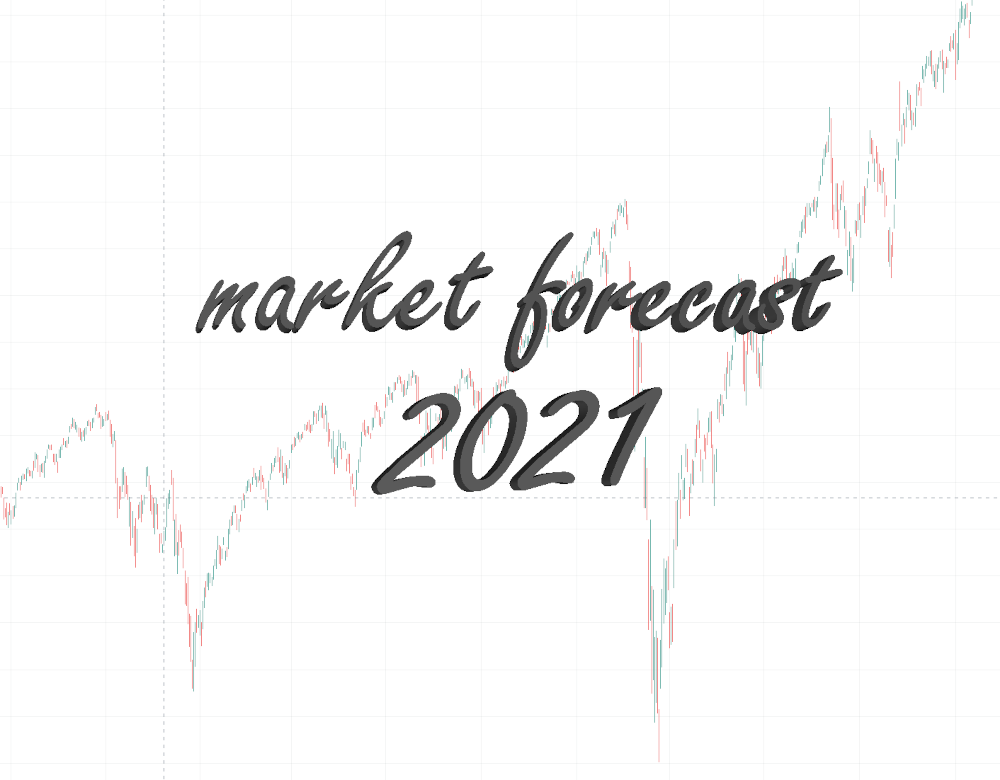2021 market forecast

I've been doing annual forecasts of the S&P 500 for the last ten years or so. Until now they were intended only for friends and family. After all: who am I to predict the future? Last year, I took to Twitter for the first time and, when everyone else was saying the opposite, publicly re-iterated my belief that the year will be positive. Unlike self-proclaimed financial experts and pundits - who remember their predictions only when they happen to be right - I take these forecasts seriously, and invest based on them. This year (albeit a little late) I've decided that it is time to make them public and available to everyone for free. Unfortunately, this is the most uncertain forecast I've ever made. I'm torn between the two options presented below, and the only way to find out which one it's going to be, is to watch the market as the year progresses.
How are these forecasts made? I analyze the past to predict the future. The details are both boring and, to some extent, proprietary. Proprietary in the sense that I've developed my method over two decades, and it's an integral part of my own trading method. Being more art than science - like any forecast - it is not a method that can be replicated or applied blindly. Good "artists" have successfully employed these ideas for 100 years and, so far, they've worked well for myself.
The second phenomenon - inextricably linked with the former - is the recognition that actions (events) in the universe occur in a wave-like manner. As outlandish as this may sound, scientists from literally every discipline - economists being among the first to do so - have, in one way or another, discovered the same principle (whether it's generally accepted or not). In other words, everything - including the stock market - repeats in a wave-like fashion. Waves interact with each other - in surprisingly complex ways - and this explains why events never repeat precisely in time or space. History does repeat, but it never duplicates itself and never in precisely predictable intervals. Try tossing a pebble into a pond (a lake or the sea will do) and, before the ripples stop, toss a second one next to it. Now observe how the ripples interact with each other - it's not quite a wave, but it's good enough to demonstrate the concept.
Why the universe behaves this way is a completely different discussion - and something I cannot answer, but there's no doubt that it does. If this idea interests you, I strongly recommend reading physicist Stephen Wolfram's monumental work: "A New Kind of Science" - completely free, in high resolution, from the author himself. But let's move on to the forecast itself.
Scenario #1 (60% likelihood)
Using my time tested (standard) methodology, this is the prognosis I came up with. The analysis points to a rather uneventful year, in every sense, which beats the alternative in every way. While there will be gains when all is said and done, they won't be spectacular. Gains will be more in line with historical returns - unlike those of the last few years. At times, it may even seem that the market is trading sideways (at least when compared to the previous decade). However, this will probably set the stage for much bigger gains in years to come (to be confirmed) if only because the current pace is not sustainable. There honestly isn't much more to be said, it's not great, but not bad! Although I have no way to know which option is more probable, the fact that this result was obtained using my "standard" parameters, fosters my belief that it is the more likely of the two. I certainly hope so!
Scenario #2 (40% likelihood)
The second sequence, or pattern, was found in a slightly less "orthodox" manner. It shows up right before the "dot com" bubble crashed in 2000. Alarmingly, it is a better fit than the one above. Although I still have higher confidence in the first option, this scenario indicates that we are close to a (temporary) peak in the market and should buckle up, or sell our positions. If this forecast becomes reality the gains of the last few years will be wiped out in a remarkably short time (just take a look at the data from 2000 yourself). Fortunately, nothing in my forecast can predict the extent or duration of such a correction or crash (so it is possible that we won't have to wait 13 years to get back where we are now). Apart from the massive, and seemingly eternal, bull market of the last decade, the sky-high valuations of almost every major technology stock form an eerie parallel to the internet bubble ~20 years ago. This outlook doesn't necessarily indicate that a crash has to come this calendar year. Sadly, it's impossible to pinpoint dates with my method - or I'd have a lot more money than I do - but we should definitely be on the lookout. The entire COVID debacle adds another element of support to this scenario. Regardless of its significance as a health risk, the actions of governments worldwide - but especially in Europe and the USA - have ensured economic consequences of catastrophic proportions. Make no mistake: Europe will be wiped off the map (as if it didn't have enough problems before this so-called "menace") through its own actions. The USA is much more resilient, but restrictions on businesses will still exact their toll. Whatever the fallout is going to be: the worst is yet to come. All these factors combined, make me very wary of the possibility than we are in a situation not unlike that of 2000 (although for different reasons). On the flip side: stocks will be that much cheaper...
So, what should you do? As mentioned above, the only reasonable course of action is to be alert and watch closely as this year develops. Based on what happens next, we can determine which one of the two options is playing out. For the time being, I see no reason to panic but plenty of reason for caution. In particular you might want to take another look at companies' valuations!
It might seem like these two options cover all possibilities, but that's far from true. There are plenty of other options! Just give it some time, and we will see whether I'm totally wrong or not. At the end of the day you'll be the judge! Besides, it's not like I'm suggesting you should invest based on the above - though you may want to keep it in the back of your head.
Full disclosure: I am and, at least for the time being, will remain invested in the S&P 500. This forecast only applies to the S&P 500, not single stocks and certainly not Europe. None of the above constitutes, or is intended as, investment advice: always use your own judgement for your investments.
